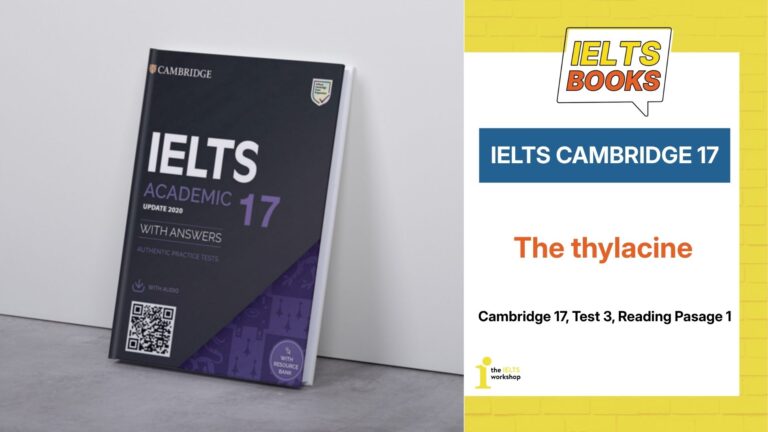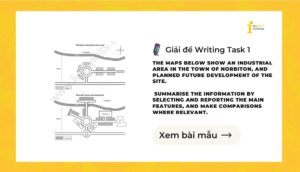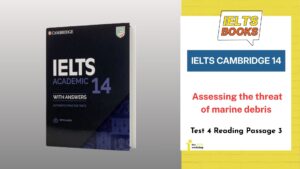Bạn đang tìm kiếm đáp án Cambridge 17 Test 3 để kiểm tra kết quả và hiểu sâu hơn về cách làm bài của mình? Trong bài viết này, The IELTS Workshop sẽ tổng hợp đáp án và hướng dẫn chi tiết IELTS Cambridge 17 Test 3 Reading Passage 1: The thylacine giúp bạn củng cố kiến thức và kĩ năng làm bài Reading của mình.
Đáp án IELTS Cambridge 17 Test 3 Reading Passage 1
| Câu | Đáp án |
| 1 | carnivorous |
| 2 | scent |
| 3 | pouch |
| 4 | fossil |
| 5 | habitat |
| 6 | True |
| 7 | Falsse |
| 8 | Not given |
| 9 | False |
| 10 | Not given |
| 11 | False |
| 12 | True |
| 13 | Not given |
Phân tích chi tiết đáp án IELTS Cambridge 17 Test 3 Reading Passage 1
Câu 1 – Đáp án: carnivorous
Question (EN): ate an entirely ________ diet
Dịch: ăn chế độ ăn hoàn toàn ________
Vị trí: Đoạn 2, câu 2.
Transcript: “In terms of feeding, it was exclusively carnivorous.”
Phân tích: Tính từ đứng sau “entirely” phải diễn tả chế độ ăn chỉ gồm một loại thức ăn. Trong bài, “exclusively carnivorous” = “entirely carnivorous”.
Câu 2 – Đáp án: scent
Question (EN): probably depended mainly on ________ when hunting
Dịch: có lẽ phụ thuộc chủ yếu vào ________ khi săn mồi
Vị trí: Đoạn 2, giữa đoạn.
Transcript: “During long‑distance chases, thylacines were likely to have relied more on scent than any other sense.”
Phân tích: “relied more on” ↔ “depended mainly on”; do đó từ cần điền là “scent”.
Câu 3 – Đáp án: pouch
Question (EN): young spent first months of life inside its mother’s ________
Dịch: con non ở trong ________ của mẹ trong những tháng đầu đời
Vị trí: Đoạn 3, câu 3.
Transcript: “Newborns crawled into the pouch on the belly of their mother… remaining there for up to three months.”
Phân tích: “pouch” là túi trước bụng mẹ – nơi con non ở 3 tháng đầu.
Câu 4 – Đáp án: fossil
Question (EN): last evidence in mainland Australia is a 3,100‑year‑old ________
Dịch: bằng chứng cuối cùng ở lục địa Úc là một ________ 3.100 năm tuổi
Vị trí: Đoạn 4, câu 2.
Transcript: “…a carbon‑dated fossil … around 3,100 years old.”
Phân tích: Danh từ số ít cần điền là “fossil”.
Câu 5 – Đáp án: habitat
Question (EN): reduction in ________ and available sources of food … responsible for decline in Tasmania
Dịch: sự giảm ________ và nguồn thức ăn… góp phần gây suy giảm ở Tasmania
Vị trí: Đoạn 5, câu cuối.
Transcript: “…loss of habitat along with the disappearance of prey species…”
Phân tích: “loss of habitat” cho thấy môi trường sống bị thu hẹp – khớp yêu cầu “reduction in …”.
Câu 6 – Đáp án: TRUE
Significant numbers of thylacines were killed by humans from the 1830s onwards.
Một số lượng lớn thylacine bị con người giết từ thập niên 1830 trở đi.
Vị trí & Transcript: Đoạn 5, câu 1: “The dramatic decline … began in the 1830s … attributed to the relentless efforts of sheep farmers and bounty hunters.”
Phân tích: “dramatic decline” do người bắn = nhiều cá thể bị giết → khẳng định.
Câu 7 – Đáp án: FALSE
Several thylacines were born in zoos during the late 1800s.
Vị trí & Transcript: Đoạn 6, câu 1: “There was only one successful attempt to breed a thylacine in captivity, at Melbourne Zoo in 1899.”
Phân tích: Chỉ “one”, không phải “several”.
Câu 8 – Đáp án: NOT GIVEN
John Gould’s prediction about the thylacine surprised some biologists.
Phân tích: Bài chỉ nói Gould tiên đoán sự tuyệt chủng, không đề cập phản ứng của các nhà sinh vật học.
Câu 9 – Đáp án: FALSE
In the early 1900s, many scientists became worried about the possible extinction of the thylacine.
Vị trí & Transcript: Đoạn 7, câu 1: “there seems to have been little public pressure to preserve the thylacine, nor was much concern expressed by scientists…”
Phân tích: Ngược lại với mệnh đề → FALSE.
Câu 10 – Đáp án: NOT GIVEN
T.T. Flynn’s proposal to rehome captive thylacines on an island proved to be impractical.
Phân tích: Bài nêu đề xuất của Flynn nhưng không nói nó khả thi hay không.
Câu 11 – Đáp án: FALSE
There were still reasonable numbers of thylacines in existence when protection during their breeding season was passed.
Vị trí & Transcript: Đoạn 7: bảo vệ tháng 12/1929; nhưng “species on the very edge of extinction”.
Phân tích: Số lượng đã rất ít → khẳng định câu nói sai.
Câu 12 – Đáp án: TRUE
From 1930 to 1936, the only known living thylacines were all in captivity.
Vị trí & Transcript: Đoạn 7: “leaving just captive specimens.” + con cuối chết 1936.
Phân tích: Tất cả cá thể còn lại đều nuôi nhốt → TRUE.
Câu 13 – Đáp án: NOT GIVEN
Attempts to find living thylacines are now rarely made.
Phân tích: Đoạn 8 chỉ nói “numerous expeditions … none produced definitive evidence”, không đề cập tần suất hiện nay.
Bản dịch chi tiết IELTS Cambridge 17 Test 3 Reading Passage 1
1. The extinct thylacine, also known as the Tasmanian tiger, was a marsupial that bore a superficial resemblance to a dog. Its most distinguishing feature was the 13-19 dark brown stripes over its back, beginning at the rear of the body and extending onto the tail. The thylacine’s average nose-to-tail length for adult males was 162.6 cm, compared to 153.7 cm for females.
Loài thylacine đã tuyệt chủng, còn được gọi là hổ Tasmania, là một loài thú có túi với hình dạng khá giống chó. Đặc điểm nổi bật nhất của nó là từ 13 đến 19 sọc màu nâu sẫm chạy dọc trên lưng, bắt đầu từ phần sau cơ thể và kéo dài đến đuôi. Chiều dài trung bình từ đầu đến đuôi của con đực trưởng thành là 162,6 cm, trong khi con cái là 153,7 cm.
Từ vựng cần nhớ:
- to bear a superficial resemblance to: rất giống với (về bề ngoài)
- distinguishing feature: đặc điểm nổi bật
- extinct: tuyệt chủng
- marsupial: thú có túi
2. The thylacine appeared to occupy most types of terrain except dense rainforest, with open eucalyptus forest thought to be its prime habitat. In terms of feeding, it was exclusively carnivorous, and its stomach was muscular with an ability to distend so that it could eat large amounts of food at one time, probably an adaptation to compensate for long periods when hunting was unsuccessful and food scarce. The thylacine was not a fast runner and probably caught its prey by exhausting it during a long pursuit. During long-distance chases, thylacines were likely to have relied more on scent than any other sense. They emerged during evening, night and early morning and tended to retreat to the hills and forest for shelter during the day. Despite the common name “tiger”, the thylacine had a shy, nervous temperament. Although mainly nocturnal, it was sighted moving during the day and some individuals were even recorded basking in the sun.
Thylacine có thể sinh sống ở hầu hết các loại địa hình, trừ rừng rậm nhiệt đới. Môi trường sống lý tưởng của nó được cho là các khu rừng bạch đàn thoáng đãng. Về chế độ ăn, chúng hoàn toàn ăn thịt, với dạ dày khỏe và có khả năng phình to để chứa lượng lớn thức ăn trong một lần — có lẽ là cách thích nghi khi phải chịu đựng những khoảng thời gian dài không săn được mồi. Loài này không chạy nhanh mà có lẽ săn mồi bằng cách đuổi theo đến khi con mồi kiệt sức. Trong các cuộc rượt đuổi đường dài, chúng có xu hướng dựa vào khứu giác nhiều hơn các giác quan khác. Thylacine thường ra ngoài vào buổi tối, ban đêm và sáng sớm, còn ban ngày thì ẩn mình trong rừng và vùng đồi. Dù có tên gọi là “hổ”, chúng có tính cách nhút nhát và hay lo lắng. Dù hoạt động chủ yếu về đêm, nhưng người ta cũng từng nhìn thấy chúng di chuyển ban ngày và thậm chí tắm nắng.
Từ vựng cần nhớ:
- carnivorous: ăn thịt
- distend: phình to, giãn nở
- pursuit: sự truy đuổi
- temperament: tính khí
- nocturnal: sống về đêm
- scent: mùi hương
3. The thylacine had an extended breeding season from winter to spring, with indications that some breeding took place throughout the year. The thylacine, like all marsupials, was tiny and hairless when born. Newborns crawled into the pouch on the belly of their mother, and attached themselves to one of the four teats, remaining there for up to three months. When old enough to leave the pouch, the young stayed in a lair such as a deep rocky cave, well-hidden nest or hollow log, whilst the mother hunted.
Thylacine có mùa sinh sản kéo dài từ mùa đông đến mùa xuân, và có dấu hiệu cho thấy một số cá thể vẫn sinh sản quanh năm. Giống như các loài thú có túi khác, thylacine sơ sinh rất nhỏ và không có lông. Sau khi sinh, con non sẽ bò vào túi trên bụng mẹ và bám vào một trong bốn núm vú, nơi chúng ở lại suốt ba tháng. Khi đã đủ lớn để ra ngoài, chúng sẽ ở lại trong tổ, có thể là hang đá sâu, tổ kín đáo hoặc khúc gỗ rỗng, trong lúc mẹ đi săn.
Từ vựng cần nhớ:
- extended breeding season: mùa sinh sản kéo dài
- hairless: không có lông
- pouch: túi (trên bụng thú có túi)
- lair: hang ổ
4. Approximately 4,000 years ago, the thylacine was widespread throughout New Guinea and most of mainland Australia, as well as the island of Tasmania. The most recent, well-dated occurrence of a thylacine on the mainland is a carbon-dated fossil from Murray Cave in Western Australia, which is around 3,100 years old. Its extinction coincided closely with the arrival of wild dogs called dingoes in Australia and a similar predator in New Guinea. Dingoes never reached Tasmania, and most scientists see this as the main reason for the thylacine’s survival there.
Cách đây khoảng 4.000 năm, loài thylacine từng phân bố rộng rãi ở New Guinea, hầu hết lục địa Úc và cả đảo Tasmania. Dấu tích cuối cùng của chúng trên đất liền là một hóa thạch có niên đại khoảng 3.100 năm từ hang Murray ở Tây Úc. Việc thylacine tuyệt chủng trùng với thời điểm chó hoang dingo xuất hiện ở Úc, và một loài săn mồi tương tự xuất hiện ở New Guinea. Vì dingo không bao giờ tới được Tasmania, nên các nhà khoa học cho rằng đây là lý do chính giúp thylacine sống sót lâu hơn ở đó.
Từ vựng cần nhớ:
- widespread: phân bố rộng
- occurrence: sự xuất hiện
- fossil: hóa thạch
- coincide with: trùng hợp với
- predator: động vật săn mồi
5. The situation for the thylacine changed dramatically when Europeans arrived in Tasmania in 1803. They regarded the thylacine as a threat to their sheep and started a campaign to eradicate it. This fear was aggravated by the thylacine’s perceived rarity, which meant farmers could not learn how to keep it from killing sheep. The Van Diemen’s Land Company introduced the first bounty system for thylacines in 1830, rewarding people for killing them. The government followed suit in 1888, paying one pound per adult and ten shillings per juvenile. Over 2,000 bounties were paid.
Tình hình của thylacine thay đổi hoàn toàn khi người châu Âu đến Tasmania vào năm 1803. Họ coi loài này là mối đe dọa đối với đàn cừu và bắt đầu một chiến dịch nhằm tiêu diệt chúng. Nỗi sợ này càng gia tăng do thylacine hiếm gặp, khiến nông dân không biết cách nào để bảo vệ cừu hiệu quả. Năm 1830, Công ty Đất đai Van Diemen là đơn vị đầu tiên khởi xướng hệ thống treo thưởng, trả tiền cho ai giết được thylacine. Chính quyền sau đó cũng tham gia vào năm 1888, với mức thưởng một bảng cho con trưởng thành và mười shilling cho con non. Hơn 2.000 phần thưởng đã được trao.
Từ vựng cần nhớ:
- to eradicate: tiêu diệt, loại bỏ
- bounty system: hệ thống treo thưởng
- aggravated: làm trầm trọng thêm
- perceived rarity: sự hiếm gặp theo cảm nhận
- follow suit: làm theo, bắt chước
6. Despite the success of these efforts, sightings of thylacines continued to be reported. The last known capture was in 1933, and the animal was sent to Hobart Zoo where it lived for three years. The thylacine was finally declared officially extinct in 1986.
Mặc dù các chiến dịch diệt trừ rất thành công, nhưng vẫn có những báo cáo ghi nhận đã nhìn thấy thylacine. Cá thể cuối cùng bị bắt là vào năm 1933 và được đưa đến Sở thú Hobart, nơi nó sống thêm ba năm. Loài thylacine chính thức được tuyên bố tuyệt chủng vào năm 1986.
Từ vựng cần nhớ:
- sighting: sự trông thấy, ghi nhận
- officially declared extinct: chính thức bị tuyên bố tuyệt chủng
- capture: sự bắt giữ
7. In the years since, the possibility that the thylacine might have survived has been fuelled by continued reports of sightings, many in Tasmania’s remote wilderness. Some researchers believe these reports are credible, while others argue that the observers may have seen dogs or other animals and believed they were thylacines.
Trong những năm sau đó, khả năng thylacine vẫn còn tồn tại tiếp tục được nuôi dưỡng bởi những báo cáo nhìn thấy chúng, phần lớn ở vùng hoang dã xa xôi của Tasmania. Một số nhà nghiên cứu tin rằng các báo cáo này đáng tin cậy, trong khi số khác cho rằng người quan sát có thể đã thấy chó hoặc các loài động vật khác và tưởng nhầm đó là thylacine.
Từ vựng cần nhớ:
- remote wilderness: vùng hoang dã hẻo lánh
- credible: đáng tin cậy
- fuel (v): tiếp thêm, khơi dậy
- observer: người quan sát
8. The debate over the thylacine’s status continues. Recent efforts to locate it have included setting up camera traps in areas where sightings were reported. Technology may increase the chances of discovering a surviving member of the species – if it still exists.
Cuộc tranh luận về tình trạng của loài thylacine vẫn tiếp tục. Gần đây, người ta đã lắp đặt các bẫy camera ở những khu vực có báo cáo nhìn thấy chúng. Công nghệ hiện đại có thể gia tăng khả năng phát hiện một cá thể còn sống – nếu như nó thực sự còn tồn tại.
Từ vựng cần nhớ:
- debate: cuộc tranh luận
- camera trap: bẫy camera
- discover: phát hiện ra
- surviving member: cá thể còn sống sót
Series giải đề IELTS Cambridge 17
- [PDF + Audio] Cambridge IELTS 17 – Cambridge Practice Tests For IELTS 17 With Answers
- Đáp án Cambridge 17 & lời giải chi tiết: Test 1 – Test 4
- IELTS Cambridge 17, Test 3, Listening Part 1: Advice on surfing holidays.
- IELTS Cambridge 17, Test 3, Listening Part 2: Childcare service.
- IELTS Cambridge 17, Test 3, Listening Part 3: Holly’s Work Placement Tutorial.
- IELTS Cambridge 17, Test 3, Listening Part 4: Bird Migration Theory.
- Giải chi tiết Cambridge 17 Reading Test 3:
- IELTS Cambridge 17, Test 3, Reading Passage 1: The thylacine.
- IELTS Cambridge 17, Test 3, Reading Passage 2: Palm oil.
- IELTS Cambridge 17, Test 3, Reading Passage 3: Building the Skyline: The Birth and Growth of Manhattan’s Skyscrapers.
- [PDF + Audio] Trọn bộ Cambridge Practice Tests For IELTS 1 – 20 mới nhất
Bạn có thể tham gia khóa HỌC IELTS MIỄN PHÍ cùng các giáo viên 9.0 tại Website The IELTS Workshop để nắm vững phương pháp học cũng như các kỹ năng làm bài thi IELTS từ thầy cô nhé!



![[PDF + Audio] Trọn bộ Cambridge Practice Tests For IELTS 1 – 20 mới nhất](https://onthiielts.com.vn/wp-content/uploads/2020/04/cam-1-14-764x400.jpg)
![[PDF + Audio] Cambridge IELTS 20: Cập nhật mới nhất (Bản đẹp)](https://onthiielts.com.vn/wp-content/uploads/2025/07/Cambridge-IELTS-20-300x169.jpg)




